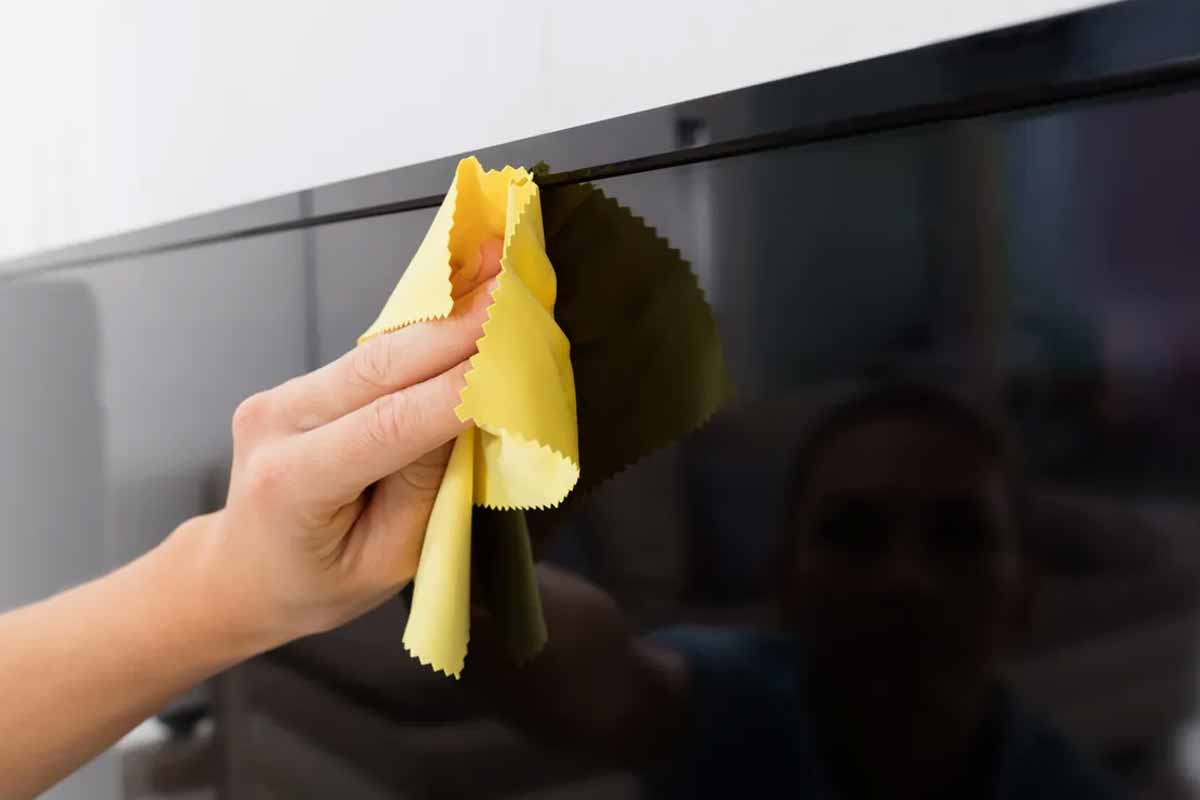A spotless screen changes the way you watch. Colors look richer, and dark scenes gain depth. Dust and fingerprints, though, creep in fast. Static pulls in particles while oils lock them down. With a gentle routine, you protect coatings and keep clarity high. Start with soft tools, then add small habits that stick. A clean TV screen does not need harsh products. It needs calm steps, light pressure, and a steady rhythm that prevents streaks.
The simple science of a TV screen and dust
Static attracts dust, while fingerprints leave oils that trap more grime. Together, they create a hazy layer that softens edges and flattens dark scenes. Tackle that film calmly, and you’ll recover detail you forgot your set could show.
Before anything, turn the television off and unplug it. Let it cool so heat won’t flash-dry moisture into streaks. Then lightly pass a dry microfiber across the panel to lift loose particles. Work with almost no pressure; pressure grinds grit into coatings.
Clean weekly to prevent build-up that later needs stronger action. Light, regular care is gentler than occasional deep scrubs. This cadence also keeps remotes and bezels from feeling grimy, which, in turn, discourages touching the TV screen during use.
Damp-cloth method: quick, safe, and effective
When dry dusting isn’t enough, use a microfiber barely dampened with water. Wring it thoroughly; droplets shouldn’t fly. Wipe with small, overlapping circles that glide, not drag. Circles help you catch streaks from multiple angles without rubbing one spot too long.
For stubborn smudges, switch to distilled water or a cleaner made for electronics. Mist the cloth, never the panel. Spot-treat the mark, then broaden outward so the edge blends cleanly. Fold the cloth often to keep lifting soil rather than redistributing it across the glass.
Finish by drying with a fresh, lint-free microfiber. Again, circles work well, though one-direction passes also minimize trails. Confirm every contour is dry before powering up; moisture trapped at bezels can wick inside. A patient, gentle pass protects your TV screen and the electronics behind it.
What never to use on a TV screen
Skip harsh chemicals entirely. Ammonia, alcohol, benzene, paint thinner, or abrasive powders can strip anti-glare coatings and etch surfaces. Paper towels and rough cloths scratch micro-layers you can’t replace. Those scratches scatter light, which looks like permanent haze.
Don’t spray liquids directly at the panel; they can seep into seams. Liquids inside the set can short components or leave mineral tracks that never polish out. A lightly moistened cloth gives control, while overspray gives you risk with almost no upside.
Big makers warn against window cleaner, soaps, and solvent mixes for good reason: coatings differ across models, but damage looks the same. Even when labels say “streak-free,” they may still degrade layers. Protect performance and warranty by treating the TV screen as a coated, not bare, surface.
Coffee filters, remotes, and other tech you touch
A surprising helper sits in your pantry: the humble coffee filter. It’s lint-free and gentle, so it excels at quick, dry dust-offs. Wrap it around two fingers, then sweep lightly. It grabs specks and lifts prints without leaving fuzz that a tissue might shed.
Keep filters dry. Adding liquid defeats their structure and can shred fibers. Use them for mid-week touchups; save the microfiber for full cleanings. That rhythm keeps static dust in check while you reserve damp passes for real grime, which protects the panel’s finish.
Don’t forget the remote. Eject batteries first. Expel crumbs between buttons with an air blower. Wipe the shell with a microfiber lightly moistened with diluted Castile soap or utilize disinfecting wipes wrung nearly dry. Dry it completely, reinsert batteries, and prevent dripping near seams—similar to the TV screen.
Keep pictures crisp: habits that prevent streaks fast
Small habits magnify clarity. Dust weekly, and tap away fingerprints as they appear. Avoid touching the panel; use bezels to reposition the set. Clear ventilation slots; better cooling reduces static, which means less dust clings in the first place.
Fighting streaks? Moisten a microfiber, then wipe in straight, overlapping lines all in one direction. Refold constantly so a clean face meets the glass. Finish with a dry pass the same way. One-direction technique leaves fewer drying marks than random patterns.
Common questions, answered concisely: Skip Windex-type products; many contain ammonia or solvents that harm coatings. Avoid eyeglass wipes; additives can be too harsh. Water is safe when used right: a wrung-out cloth, gentle motion, and patient drying. That approach protects your TV screen while restoring pop and depth.
Small habits that keep images sharp day after day
Great picture quality comes from simple care you repeat. Power down, let the set cool, and dust with a clean microfiber. Use water on the cloth, not on the panel, and dry with patience. Skip strong chemicals that strip coatings and leave marks you cannot fix. Work the remote and vents into the same routine. With these steady moves, you cut haze, stop streaks, and keep your TV screen crisp for every show.
